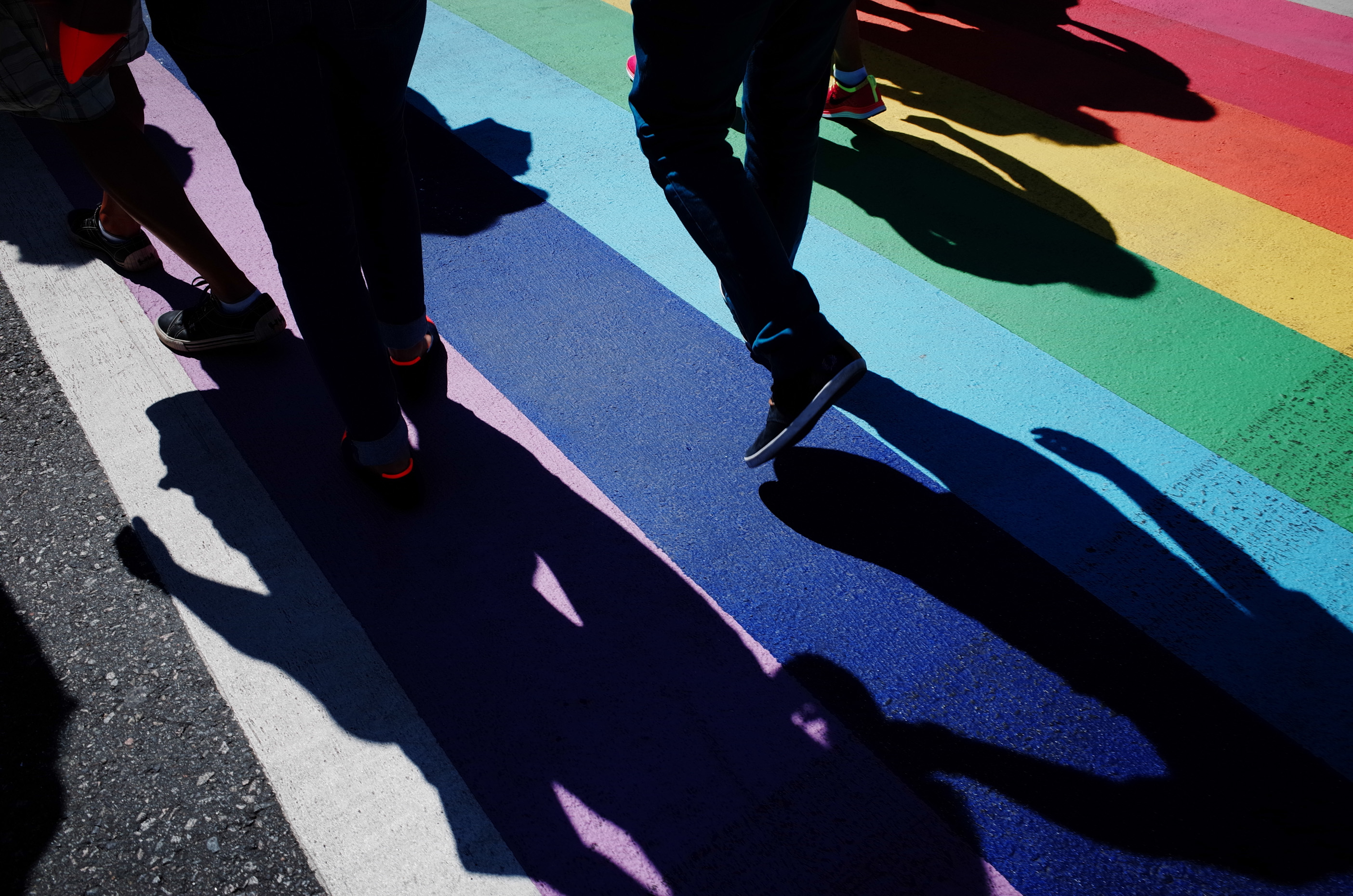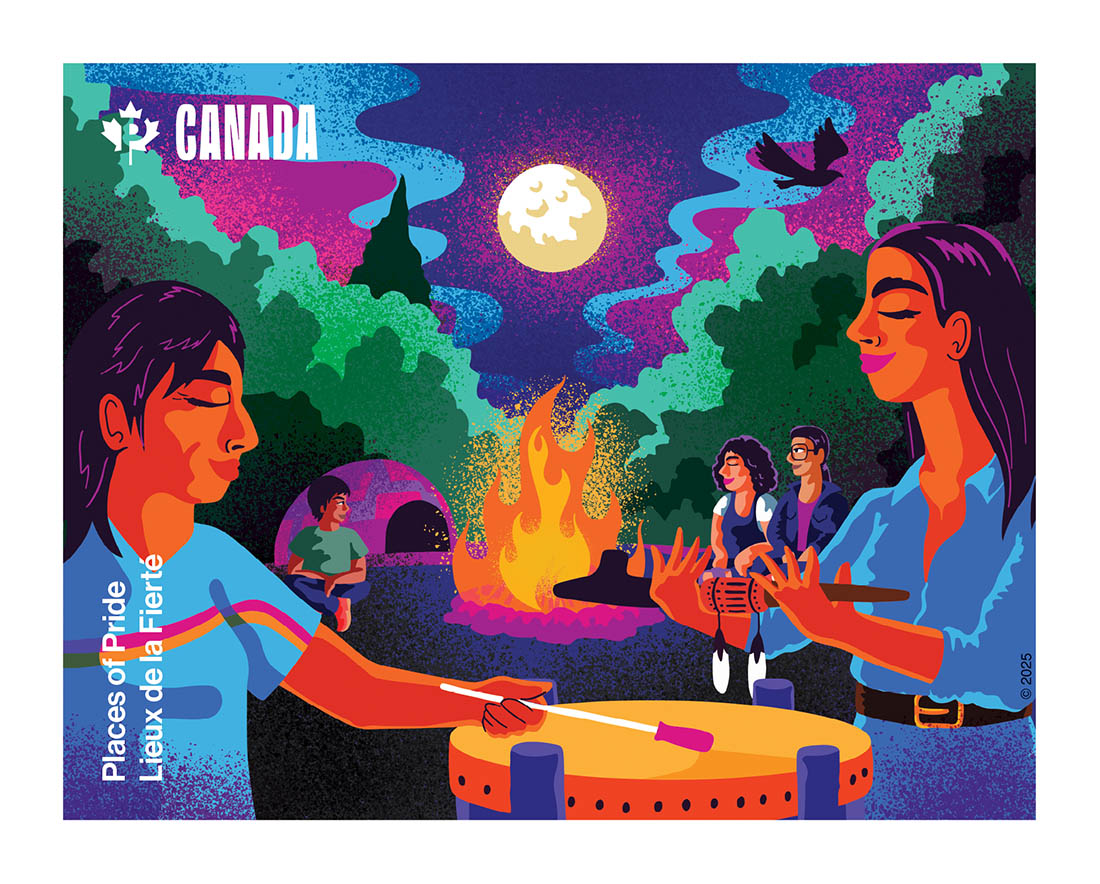Two-Spirit, a translation of the Anishinaabemowin term niizh manidoowag, refers to a person who embodies both a masculine and feminine spirit. The concept of two-spirit was first introduced by Elder Myra Laramee. Activist Albert McLeod helped develop the term in 1990 to broadly reference Indigenous peoples in the lesbian, gay, bisexual, transgender and queer (LGBTQ) community. Two-spirit is used by some Indigenous peoples to describe their gender, sexual and spiritual identity. (See also 2SLGBTQ+ Rights in Canada.)

Pre-Colonial Uses of the Term
Different Indigenous cultures have their own variations of the term two-spirit. However, these terms have historically been used to describe similar traits embodied by two-spirit people including gender identity, specialized work roles, same-sex attraction and spiritual identity.
Two-spirit commonly referred to gender identity, dress and traditional roles. The Cree terms napêw iskwêwisêhot and iskwêw ka napêwayat respectively reference men who dress like women and women who dress like men. The Siksika (Blackfoot) term aakíí’skassi described men who performed roles typically associated with women, such as basket weaving and pottery-making. Similarly, the Ktunaxa (Kootenay) term titqattek described females who took on roles traditionally characterized as masculine, including healing, hunting and warfare. One of the most well-known two-spirit people who identified as female was We’wha (1846–96) of New Mexico. She was referred to as lhaman or “mixed gender” in the Zuni language. In various Indigenous cultures, temperament, work roles, dress and lifestyle distinguished two-spirited individuals from men and women.
In some cases, the term referred specifically to sexuality. However, two-spirit people did not necessarily see themselves as homosexual; sexual relationships between a two-spirit person and a non-two-spirit person were considered hetero-normative. European colonists considered two-spirit people homosexual, and the modern usage of the term can describe homosexual people. Historically, two-spirit people did not so easily identify as either homosexual or heterosexual.
Two-spirit also referred to spiritual identity. In many Indigenous communities, two-spirited individuals were believed to have received supernatural intervention in the form of dreams and visions. As such, they often filled special spiritual roles in their communities as healers, shamans and ceremonial leaders (see Religion and Spirituality of Indigenous Peoples in Canada). Historically, two-spirit people were also great sources of knowledge; they were keepers of traditions and tellers of creation stories.
Two-spirit was a complex role and identity that modern-day two-spirited individuals can use to reclaim traditions related to gender identity, sexual preference, spiritual identity and traditional roles.
Two-Spirit Traditions Post-Contact
From the 17th to the 19th century, European missionaries and explorers often wrote about their interactions with two-spirit people. These records demonstrate the initial endurance of two-spirit traditions after contact. British explorer of the Hudson’s Bay Company Alexander Henry described two-spirit Ozaw-wen-dib in his journal as “a curious compound of man and woman.” In his exploration records, the North West Company’s David Thompson wrote about his encounter with Kaúxuma Núpika, a person who Thompson claimed “declared her sex changed, that she was now a Man, dressed and armed herself as such, and also took a young woman to Wife.”
In their records, missionaries and explorers often used the term berdache to refer to two-spirit people. Historically, the term referred to the younger partner in a homosexual relationship with an age disparity. By the early 20th century, berdache became the accepted anthropological term for two-spirit people. Overtime, it became a general term for male homosexual people and is now generally considered outdated and offensive.
Fewer accounts of two-spirit people were recorded by the turn of the 19th century. Colonization, Christian missions and instruments of cultural assimilation, including the residential school system, served to silence two-spirit traditions in some Indigenous communities.
Contemporary Usage of the Term
In the early 1990s, as part of an effort to reclaim traditions, Indigenous peoples sought to find a word or phrase originating from an Indigenous community to replace berdache. Although there were terms in various Indigenous languages to describe third and fourth genders (i.e., men-women and women-men) as well as homosexual people, they wanted a contemporary term that could be used by the general public.
At the third annual Intertribal Native American, First Nations, Gay and Lesbian American Conference, held near Winnipeg, Manitoba in 1990, activist Albert McLeod proposed Elder Myra Laramee's term two-spirit to refer to the Indigenous LGBTQ community. The term was well received by the conference attendees and soon gained popularity within Indigenous communities. The term is used today to broadly reference the Indigenous LGBTQ community. Some two-spirit societies also use the terms 2SLGBTQ+ or LGBTTIQQ2S (Lesbian, Gay, Bisexual, Transsexual, Transgender, Intersexual, Queer, Questioning, 2-Spirited) to incorporate two-spirit people within the larger LGBTQ community.

2SLGBTQ+ Awareness
From the 1990s to the present, awareness about two-spirit people has increased both within and outside Indigenous communities. Organizations such as the National Confederacy of Two-Spirit Organizations (NC2SO) and the Northeast Two-Spirit Society (now known as the East Coast Two Spirit Society, EC2SS) seek to educate the general public about two-spirit traditions. They also serve as sources of support for Indigenous LGTBQ individuals. In January 2013, NC2SO and EC2SS created a resource directory of two-spirit groups in Canada and the United States.
Despite growing awareness, some two-spirit people continue to face sexual and gender discrimination and violence in communities that are not accepting of their gender identity. In 2001, Fred Martinez, a 16-year-old Navajo two-spirit person, was beaten to death near Cortez, Colorado. The film Two Spirits (2009) documents this tragic story while also exploring the history of 2SLGBTQ+ identity in many Indigenous cultures. The Martinez murder, as well as other well-known cases, such as the murder of HIV/AIDS activist and self-identifying two-spirit Dolan Badger on 12 January 2013 in Edmonton, Alberta, have served to ignite conversations about 2SLGBTQ+ rights in Canada and the United States .
In 2013, on the eve of National Aboriginal Day (now National Indigenous Peoples Day) and World Pride Toronto, Egale Canada Human Rights Trust – Canada’s only national charity promoting 2SLGBTQ+ rights through research, education and community engagement – announced the launch of the Two Spirits, One Voice program. Designed by two-spirit people from across Canada, this program aims to “bolster allyship with indigenous communities and educate youth, police and community service providers on the historical and contemporary roles of Two Spirit Canadians.” The program serves to highlight two-spirit voices, reclaim traditions and make Indigenous communities and urban spaces safer for two-spirit people.
Did you know?
On National Indigenous Peoples Day in 2020, the organizations We Matter, Taxi and Facebook Canada launched a social media campaign, asking Indigenous youth to define what two-spirit means to them. Submissions were compiled into a dictionary about the term.
Reclaiming Two-Spirit Identity

A key aspect of the two-spirit movement has been to reclaim pre-colonial traditions. Indigenous support groups in various First Nations communities have helped to provide two-spirit people with health counselling, the advice of Elders and the opportunity to participate in sharing circles —small-group discussions in which participants can openly express their feelings and experiences, without fear of judgement. In many communities, art has also become an important element of the reclamation and sharing process. Art provides two-spirit people with a way to communicate their identities, traditions and stories with non-two-spirit people.
Renowned Cree artist Kent Monkman has given a voice to two-spirit communities. In his art, Monkman explores homosexuality and the ways in which Indigenous peoples have been portrayed in 19th and 20th century paintings. Through his depictions of homosexuality, Monkman’s art showcases Indigenous stories, traditions and perspectives that were suppressed with the influence of colonialism and Christianity. As a means of exaggerating the “egotistical” perspectives of 19th century painters, Monkman developed an alter-ego drag persona in 2010: Miss Chief Eagle Testickle, who is a recurring character in his paintings, videos and performances. Monkman’s artwork has served as an inspiration for those who seek to reclaim and promote two-spirit traditions.
For some two-spirit people, drag can be an effective way of exploring and expressing their identities. In a well-known example, Massey Whiteknife, a 35-year-old member of the Mikisew Cree First Nation and business owner in the subarctic Alberta oil sands, also identifies as ICEIS Rain, a female karaoke performer. Whiteknife explains that Rain helps him to overcome a personal history of sexual abuse and bullying. Rain first gained notoriety for her performances in 2013 as a featured entertainer in the Canadian documentary, Oil Sands Karaoke. Since then, Rain has released her first album, The Queen — a collection of ballads and country-rock songs meant to inspire 2SLGBTQ+ individuals to embrace their identity. In 2014, her album was nominated for both Best New Artist and Best Rock CD at the Aboriginal People’s Choice Music Awards (now Indigenous Music Awards). Rain also became the first two-spirit person to perform at the Aboriginal People’s Choice Music Awards.
In recent years, films have also served to highlight two-spirit traditions and identities. In 2007, a National Film Board of Canada documentary First Stories – Two Spirited, discussed the difficulty of living the life of a two-spirit person. Directed by Sharon A. Desjarlais, the film told the story of Rodney “Geeyo” Poucette, a two-spirit person who struggled to find acceptance in his community. Fire Song, a 2015 film by Cree-Métis director Adam Garnet Jones, also explores the difficulty some two-spirit people face in finding acceptance. In the film, the title character, Shane (Andrew Martin), a young Anishinaabe man, must choose between staying in his community and exploring the world outside his reserve.
Through various forms of self-expression, two-spirit people have found ways to communicate their views and pre-colonial traditions, while also showcasing their own personal stories and identities.
In 2024, ahead of the 35th anniversary of the creation of the term two-spirit, a two-spirit pride flag was unveiled at the Canadian Museum of Human Rights. The flag was designed by Anishinaabe artist Patrick Hunter and includes two eagle feathers, the sun and a rainbow design created using dots.
Significance
Two-spirit organizations, individuals and the term itself mark a return to Indigenous cultural traditions that have historically recognized more than two genders. As Jeremy Dutcher, Wolastoqiyik (Maliseet) activist, educator, award-winning musician and program coordinator of Two Spirits, One Voice, said on the eve of World Pride in Toronto, Ontario, “There is a long history of acceptance of Two Spirit people here on Turtle Island [North America] before the arrival of the European Settlers. This pride is returning to our communities.” Two-spirit societies continue to raise awareness about 2SLGBTQ+ individuals in communities across North America.

 Share on Facebook
Share on Facebook Share on X
Share on X Share by Email
Share by Email Share on Google Classroom
Share on Google Classroom


